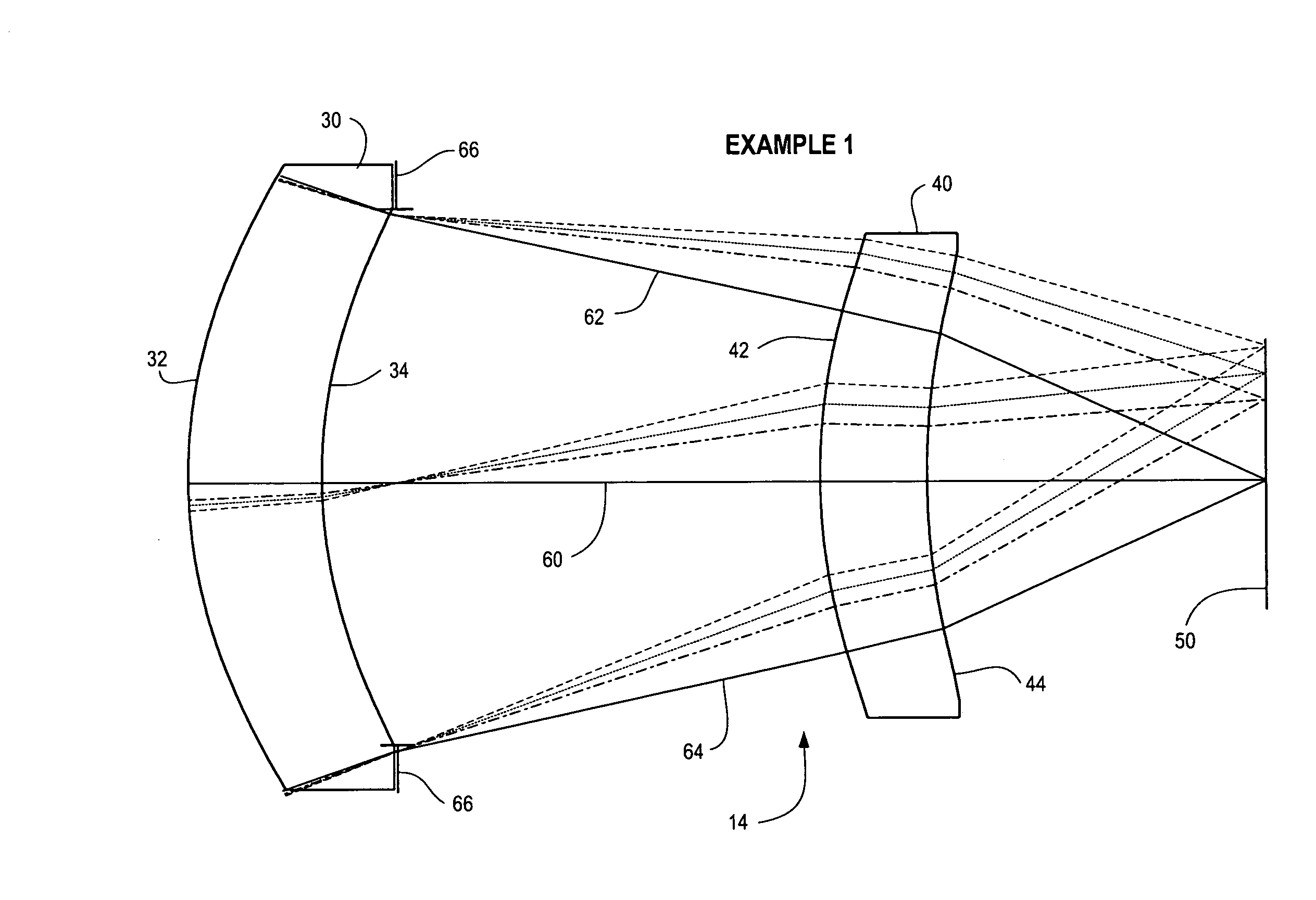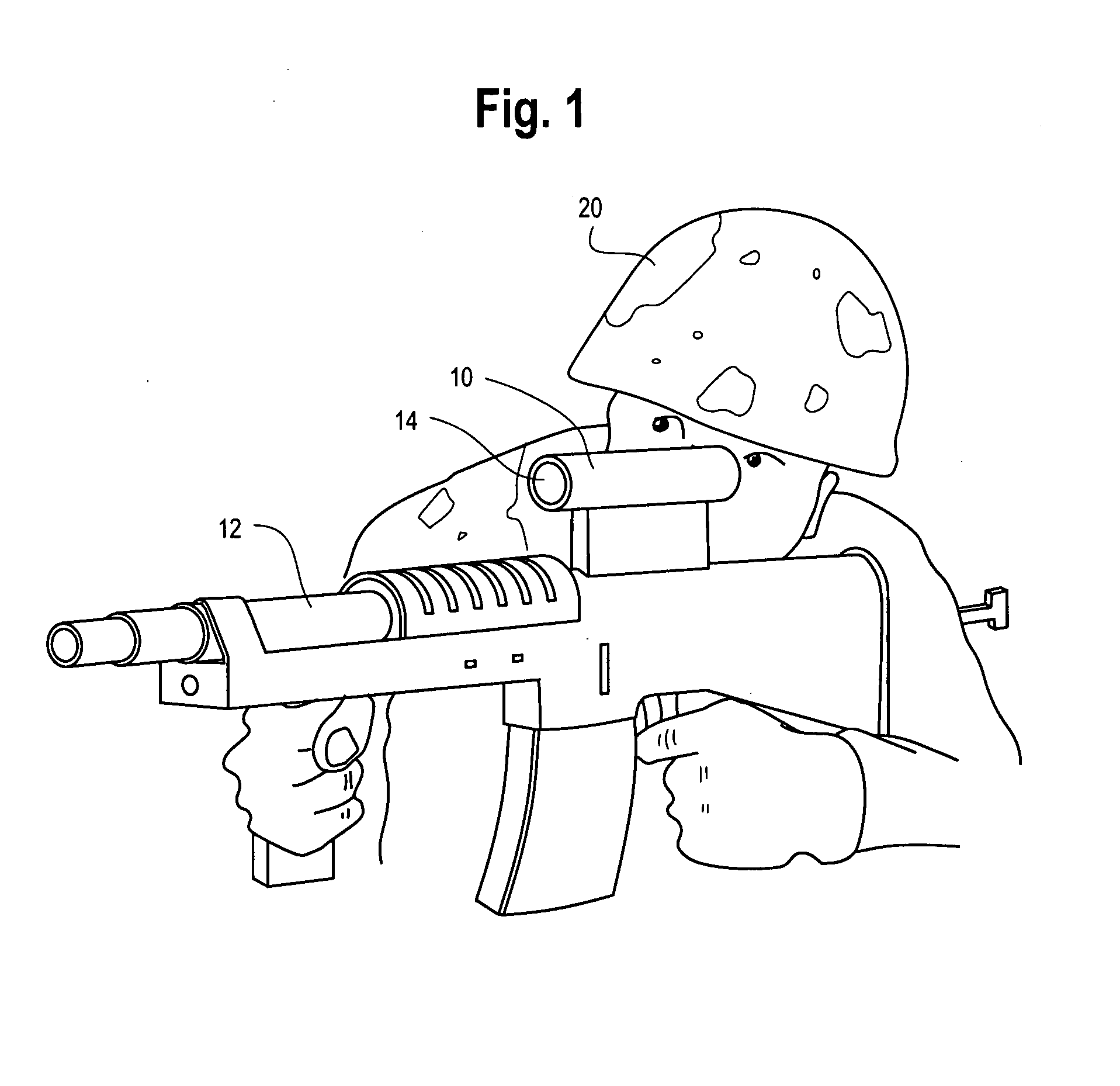Compact two-element infrared objective lens and IR or thermal sight for weapon having viewing optics
a two-element, infrared objective technology, applied in the field of relativly compact imaging lens arrangement of infrared optical system, can solve the problems of difficult design to achieve diffraction-limited performance, prior art lens design is not particularly suitable for use with thermal or ir sights for small arms
- Summary
- Abstract
- Description
- Claims
- Application Information
AI Technical Summary
Benefits of technology
Problems solved by technology
Method used
Image
Examples
example 1
28.3 mm Focal Length, F1.1 Two Element IR Objective Lens (FIG. 2)
[0026]FIG. 2 is an illustration of a lens design in accordance with a first embodiment. The design is optimized to operate in the long-wave infrared (LWIR) band of the electromagnetic spectrum. The design features two lens elements 30 and 40. Front surface 32 of the first lens element 30 is convex and receives incident radiation from the scene. Rear surface 34 is concave. The front surface 42 of the second lens element 40 is convex and the rear surface 44 is concave. Surfaces 32, 34, 42 and 44 are aspherical. The details of the prescription of the lenses are set forth in the Appendix A. The lens elements 30 and 40 are made from germanium in the illustrated embodiment. The lens elements direct radiation onto the focal plane 50. A thermal or IR detection device (not shown) is placed at the focal plane 50.
[0027]The design has a 28.3 mm focal length, an f-number of 1.1, and a field angle of ±11.2 degrees (total field-of-vi...
example 2
50.3 mm F1.4 Two Element IR Objective Lens (FIG. 10)
[0037]FIG. 10 is an illustration of a lens 14 in accordance with a second embodiment. The lens is designed to operate in the long-wavelength infrared. The lens features a first lens element 30 with front and rear surfaces 32 and 34, and a second lens element 40 having front and rear surfaces 42 and 44, respectively, which direct incident light from a scene and form an image on a focal plane 50. Surfaces 32 and 42 are convex and surfaces 34 and 44 are concave. A detection device (not shown) for detecting radiation in the IR portion of the spectrum is located at the focal plane 50. An aperture stop 66 is placed between the first and second lens elements 30 and 40.
[0038]Lens surfaces 34, 42 and 44 are aspherical. Lens surface 32 is spherical. The prescription for the lens elements 30 and 40 are given in Appendix B. The lens elements are constructed from germanium.
[0039]The design has a 50.3 mm focal length, f-number of 1.4, and a fiel...
example 3
101.4 mm F1.4 Two Element LWIR Objective Lens (FIG. 18)
[0043]FIG. 18 is an illustration of a lens design 14 in accordance with a third embodiment. The lens 14 features a first lens element 30 and a second lens element 40 which together form an image on a focal plane 50. Surface 32 of lens element 30 is convex relative to the focal plane 50; surface 34 of lens element 30 is concave relative to the focal plane 50. Surface 42 of lens element 40 is concave, as is lens surface 44. Surface 32 is spherical and surfaces 34, 42 and 44 are aspherical. The prescription of the lens 14 is given in Appendix C. The lens is designed to operate in the long-wave infrared. Accordingly, the lens elements 30 and 40 are constructed from a material selected to pass radiation in this band. In this example lens element 30 is made from germanium and lens element 40 is made from zinc sulfide.
[0044]An aperture stop 66 is placed adjacent to the lens element 30 between the first and second lens elements 30 and 4...
PUM
 Login to View More
Login to View More Abstract
Description
Claims
Application Information
 Login to View More
Login to View More - R&D
- Intellectual Property
- Life Sciences
- Materials
- Tech Scout
- Unparalleled Data Quality
- Higher Quality Content
- 60% Fewer Hallucinations
Browse by: Latest US Patents, China's latest patents, Technical Efficacy Thesaurus, Application Domain, Technology Topic, Popular Technical Reports.
© 2025 PatSnap. All rights reserved.Legal|Privacy policy|Modern Slavery Act Transparency Statement|Sitemap|About US| Contact US: help@patsnap.com



